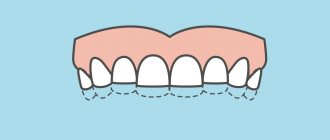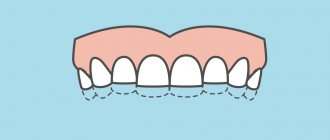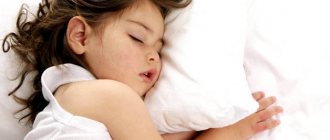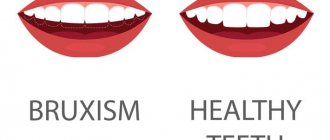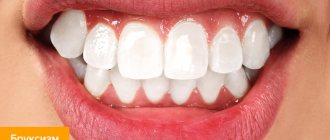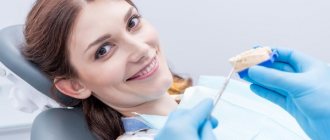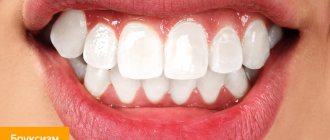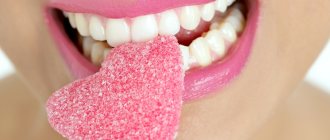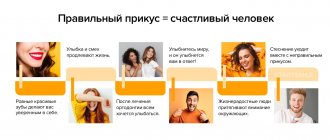Teeth grinding (bruxism) is a common problem in children and a cause of concern for parents. This phenomenon does not apply to diseases. This is a symptom that signals various malfunctions in the endocrine, digestive and nervous systems of the child’s body. Here it is necessary to pay attention to other changes in the child’s behavior. Only a doctor can determine the exact cause after a thorough examination.
In this article we will try to find out why a child may grind his teeth, how dangerous it is, and what to do in this case.
What is bruxism and its manifestations
Bruxism is a pathological condition that occurs due to excessive clenching of the jaws.
By the age of 5 years, teeth grinding occurs in almost 50% of children. This occurs involuntarily and is associated with a spasm of the masticatory muscles. Usually the pathology occurs at night, in attacks of 10-15 seconds. Attacks may recur during the daytime. At the same time, daytime teeth grinding causes more concern for parents, since it is more noticeable.
Reference!
Isolated cases of teeth grinding are not dangerous and do not require intervention. If the attacks become chronic, you need the help of a pediatrician.
In addition to grinding teeth, a child may experience the following manifestations of pathology:
- headache;
- daytime drowsiness, lethargy;
- neck pain;
- tearfulness;
- tooth sensitivity is the result of abrasion and damage to the enamel;
- restless sleep with frequent awakenings;
- congestion in the ears.
Dentists identify a triad of symptoms in childhood bruxism (up to 5 years). These are erosive wear of baby teeth, malocclusion and narrowing of the dental arches. Teeth grinding usually goes away on its own when a child reaches puberty. Teeth grinding is a rare occurrence among teenagers and young adults.
Comprehensive treatment of bruxism
- Relieving pain in the masticatory muscles and correcting the tone of the masticatory muscles using splints and disconnecting mouth guards, as well as Botox injections into the masticatory muscles.
- Treatment of dysfunction of the mandibular joint with conservative or surgical methods. The choice of treatment method depends on the severity of the condition. Plastic surgery of the articular disc, arthrolavage of the joint cavity (a minimally invasive surgical procedure consisting of puncture, lavage of the joint and administration of drugs that promote the restoration of joint tissue) and other methods can be used. Physiotherapy (laser, electrophoresis, dynamic currents, massage) is also widely used, relaxing muscles and strengthening ligaments.
- Restoration of dentition after correction of the tone of the masticatory muscles and treatment of dysfunction of the mandibular joint.
Reasons for grinding your teeth in your sleep
The exact causes of pathological teeth grinding have not been fully elucidated. In most cases, attacks occur at night, so sleep disturbances are a common cause. In children, this is associated with hypertrophy of the tonsils and adenoids, which makes nasal breathing difficult and leads to apnea (suspension of breathing during sleep). Obesity is also a provoking factor.
Other possible reasons why a child may grind their teeth:
- Incorrect deep bite.
- Individual characteristics of the inclination of the lower jaw.
- Nervous tension, emotional overexcitement.
- Hereditary predisposition.
- Neurological or endocrine disorders.
- Teething.
The causes and manifestations may vary depending on what time of day bruxism occurs.
Night grinding of teeth
If during sleep you notice several attacks, and at the same time the child behaves restlessly (breathing quickens, pupils move actively, talks), then the reason is emotional overexcitement. More often this manifests itself in emotionally sensitive children, overly active or with hyperexcitability syndrome.
Nocturnal bruxism can also be triggered by stress - moving to a new apartment, entering kindergarten, parental divorce, or frequent scandals at home. During the daytime, the child tries not to show his emotions and tension accumulates, and at night it “splashes out” through clenching his jaws and grinding his teeth.
In some cases, the provocateur may be a regular filling that was installed incorrectly. It may prevent the jaw from closing tightly, and the child is too young to tell. Difficulty nasal breathing and snoring of a child during sleep are a sign of problems with the adenoids. In this case, you need to consult an ENT doctor.
Teeth grinding during the daytime
During the day, the baby may experience a spasm of the chewing muscles due to tooth eruption. It is also possible to develop an incorrect bite, which leads to discomfort and clenching of the jaws. In these situations, you need to show the child to the dentist.
During a stressful situation, involuntary grinding of teeth is possible. Observe when this phenomenon occurs in the child during the day, and what precedes it. For frequent attacks, consultation with a child psychologist or neurologist is recommended. Problems with the digestive and endocrine system can also cause attacks of daytime bruxism.
What to do, how to treat
To relieve muscle tension, you need to take the following steps:
- stop drinking any alcohol, especially in the evening
- Avoid caffeine-containing products (tea, coffee) for a while
- reduce the dose of chocolate intake
- stop drinking stimulating drinks like Coca-Cola, Sarmat beer, extracts containing mate at night
- before going to bed, relieve tension in the masticatory muscles with a warm compress
- contact an orthopedic dentist and choose a mouthguard that is installed on the teeth as protection while sleeping, corrects the bite, this is well described in the video:
if the above is useless, we turn to doctors to prescribe antidepressants and muscle relaxants (they relax the muscles)
In general, bruxism is not considered a disease. And in order to overcome it, you need, first of all, to find out the reason for its occurrence.
How to get rid of bruxism
First you need to see a doctor - a dentist or an orthopedist, and let them check whether your bite is correct. If the bite is fine, there may be a problem with the filling or denture. In this case, the filling is undermined or the denture is well fixed. Your dentist can also recommend and make a mouth guard especially for you (a device that is worn at night to prevent your teeth from rubbing against each other). But the latter will not overcome the fact that you grind your teeth, it will only protect them so that they do not deteriorate.
If you have abdominal pain, nausea, problems with appetite, get checked, it may be worms, but, as previously noted, this extremely rarely causes bruxism.
If it’s not the first or the second, most likely the nervous system is to blame for grinding your teeth in your sleep. In this case, you need to analyze when and why you get nervous, learn to manage your emotions and not take problems so personally. You can also contact a psychotherapist for advice.
Try to be more calm about problems. There is no need to constantly be in tension.
To relax your jaw before bed, apply a warm towel or heating pad to it. Or, on the contrary, before going to bed, eat a salad with raw vegetables, or just an apple or carrot. Then your jaw will tense to the point of exhaustion and will be relaxed at night (the latter works well on children).
Throughout the day, try not to chatter or grind your teeth, or close them unless necessary (except when eating, of course).
When something is wrong at work or at home, do something pleasant and relaxing in the evening - take a relaxing bath or shower, drink herbal tea with mint, go to sports training, take a walk before bed.
This will not only be an effective method of combating bruxism, but will also bring a lot of pleasant and bright emotions into your life.
Watch the doctor's recommendations in more detail in the video:
Today we found out whether teeth grinding in a dream is a sign of the presence of worms (helminths) in the human body, especially a child, we looked at the main causes of teeth grinding, we found out which parasite - just one - can cause bruxism and what needs to be done to solve this problem. Problems.
What about worms?
There is a common belief that teeth grinding may be a sign of a parasitic disease. This is due to the fact that preschool children often suffer from helminths. And it is precisely at this age that teeth grinding is typical. Also, this assumption was explained by the fact that when infected with helminths, salivation increases. This provokes clenching of the jaws, which leads to teeth grinding. But according to specialist research, this is just a coincidence. A direct connection between the presence of worms in a child and bruxism has not been identified.
Tests for worms: which are more effective?
So, what tests need to be taken to diagnose a parasitic infection?
- Complete blood count with leukocyte formula. An eosinophil count of 5 or higher may indicate a parasitic infection. The downside is that the analysis does not reveal a specific type of worms and often shows only acute infection with parasites or an exacerbation of a chronic process. Blood sampling can be either from a finger or from a vein.
- A blood test from a vein for total immunoglobulin E. It is nonspecific, does not identify a specific type, and may remain elevated for a long time even after therapy.
- Stool tests, scrapings. Unreliable if the parasite is extraintestinal or feces are donated less than 3 times.
- Testing blood from a vein for antibodies. Quantitative analysis is informative (numbers 1:110, 68.3, etc.), and not qualitative, when the results write “positive.” or “neg.”, so ask the laboratory in advance. The disadvantages are that the tests are expensive and there are many more parasites than tests for them. Perfectly identifies both intestinal and tissue forms. The doctor must be able to correctly interpret the tests, for example, an increase in antibody titers after therapy does not at all indicate the proliferation of new parasites.
- Duodenal sounding. Used for some intrahepatic forms. For example, for the diagnosis of opisthorchiasis, only the results of this study can be a criterion for final cure.
About the fact that you need to stick tape to the baby’s bottom at night or shine a flashlight into the baby’s bottom at night, I hope you will already understand that this is ineffective and belongs to the category of village superstitions.
Is bruxism dangerous and what could be the consequences?
Bruxism does not lead to serious health problems, and certainly does not threaten the development and life of the child. Most of all, parents are worried about this phenomenon, and they begin a hospital quest in search of the cause. As a rule, the child grows out of this problem without the participation of a doctor, if it is not chronic. This is due to the development of the chewing apparatus, eliminating problems with the adenoids and normalizing sleep.
If teeth grinding occurs frequently over several months, then a doctor’s consultation is necessary. Otherwise, bruxism can lead to the following consequences:
- thinning of tooth enamel and increased sensitivity of teeth;
- problems with fillings, they will crumble and crack;
- malocclusion;
- loosening of baby teeth;
- headaches and decreased concentration;
- overload of the maxillofacial joint;
- spasm of the facial muscles.
Excessive tooth wear increases the risk of bruxism during adolescence and young adulthood. Also, severe uncontrolled spasm of the jaws can lead to dislocation of the temporomandibular joint.
Treatment of bruxism in adults
By adolescence, bruxism in many children goes away on its own. Teeth clenching is not severe in most adults, so therapy may not be needed at all. However, in order to avoid serious problems, you should consult your doctor.
When treating bruxism, it is necessary to determine the reasons that influenced its development. Sometimes you may need to consult a psychotherapist who will prescribe medications to normalize sleep and relieve increased anxiety.
What to do if your child grinds his teeth in his sleep
Pay attention to when attacks most often occur - during the day, at night, at home or in a public place. Also record other disturbances in the child’s behavior and health complaints. Consult a pediatrician or pediatric dentist for advice. Take the necessary tests and undergo examinations prescribed by your doctor.
The following tips will also help you cope with bruxism:
- Improve the psychological climate at home. Try not to quarrel with loved ones in front of your child, talk to your child more often and ask him to talk about his feelings and fears.
- Do not burden your child with various early development clubs.
- Organize a proper daily routine with mandatory daytime sleep. The child’s nervous system needs a break during the day, even if he himself seems active and does not want to sleep. 1-2 hours before bedtime, take a bath with relaxing additives and read a book. Active games should be prohibited.
- Review your diet. Add solid vegetables to your menu to provide exercise to your chewing muscles.
If your baby often catches colds or suffers from a chronic runny nose or nasal congestion, then you need to check the adenoids. If the child has hyperactivity syndrome and emotional excitability, it is recommended to visit a psychologist or neurologist.
Reducing the manifestations of bruxism yourself at home
- Eliminate stressful situations - take warm, soothing baths with oils and herbs before bed, listen to pleasant music, sign up for a relaxing massage. Remember that the main reason for the development of bruxism is psychological problems, so try to relieve stress in any way that is pleasant for you.
- Getting a full night's sleep can significantly reduce the symptoms of bruxism.
- In the evening, exclude from your diet drinks containing caffeine (coffee, strong tea), sweet carbonated drinks (Pepsi, cola) and chocolate.
- Stop smoking and drinking alcohol in the evening.
- Warming compresses on the area of the masticatory muscles before bedtime have a vasodilating and relaxing effect.
- Chewing gum increases the tone of the masticatory muscles, so their use is not advisable. For the same reason, try not to chew pens and pencils. During the daytime, try not to clench your teeth excessively. Learn to relax your jaw muscles: close your lips and try to keep the tip of your tongue between your teeth.
It should be understood that bruxism and teeth grinding indicate serious problems with the teeth, chewing muscles and jaw joint. These problems are treated by gnathology, a branch of medicine that involves the diagnosis and treatment of problems with bite and dentition, along with the treatment of diseases of the masticatory muscles and mandibular joint. Remember that the sooner you contact a specialist and begin treatment for bruxism, the easier it will be to avoid various problems and complications associated with this disease.
Treatment and prevention of teeth grinding during sleep
There is no specific treatment for bruxism, since this pathology is not an independent disease. The main task of the doctor is to identify the cause of the pathology. The treatment regimen will depend on this. To eliminate teeth grinding, drug therapy, physical therapy, correction of the emotional state and dental methods are used, for example, installing protective mouthguards on the teeth.
Main methods of therapy:
- Normalization of sleep with the help of sedatives.
- Taking B vitamins, preparations with magnesium and calcium.
- Treatment of adenoids.
- Psychological correction - art therapy, music therapy, sandbox. Working with parents in the presence of intra-family conflicts.
To relieve muscle tension, you can use pine baths, massage and exercise in the pool.
The dentist helps protect teeth from abrasion by installing a special protective mouth guard. It is made of soft material, so it does not cause discomfort. It can only be worn at night. The most optimal way is to make mouth guards based on an individual impression. But you can also buy ready-made ones. This method is only suitable for schoolchildren.
Also, if there is damage to the enamel and sensitivity, fluoridation and remineralization of teeth are performed. If necessary, caries treatment is carried out.
An orthodontist will help you correct your bite. For this purpose, plates and bracket systems are used. The orthodontic design is selected individually, based on the severity of the problem and the age of the child. A malocclusion can be easily corrected when the jaws have not yet fully formed. Therefore, the sooner you visit a pediatric orthodontist, the better the result will be.
How to prevent bruxism: recommendations for parents
The main preventive measure is to create a comfortable, calm and trusting atmosphere at home. Even if you think that everything is fine in your family, your child may think differently.
Try to help your child cope with emotions. Communicating with animals, drawing a picture of a problem, and using toys as interlocutors helps a lot.
Do not ignore preventive examinations from specialists. Treat caries promptly. Try to enrich your child’s diet with vitamins, do not chop food. Walk outdoors every day.
A single grinding of teeth is not a cause for concern. But if attacks of bruxism become more and more frequent, then consult a doctor to identify the cause.
Treatment of bruxism at the dentist
Depending on the pathology, either orthodontic treatment of malocclusion or restoration of the height of worn teeth using dental prosthetics with crowns or ceramic onlays can be used. Remineralization therapy and fluoridation are also used to preserve hard dental tissues.
Dental treatments alone cannot stop bruxism; they only protect teeth from further decay and premature wear.
- Splints and release guards are used during sleep to protect teeth from excessive clenching and grinding. They are usually made from acrylic or other soft and lightweight materials.
- Dental prosthetics with artificial crowns or ceramic onlays are used for severe forms of bruxism (with significant abrasion of the chewing surfaces of the teeth). Crowns and onlays perform a restorative and protective function, protecting teeth from further destruction.
- Selective grinding of teeth is aimed at eliminating increased occlusal stresses by creating correct contacts between the upper and lower teeth. This corrects the incorrect relationship between the chewing surfaces of the upper and lower teeth.
Types of parasites
There are a great many organisms that live off of us. Currently, more than 200 species of parasites have been identified in humans. Here are the most common ones.
Toxoplasma
Affects the nervous system, liver, spleen, skeletal muscles and myocardium. Most dangerous for pregnant women. If the expectant mother gets sick with toxoplasmosis, the child will most likely be born with deformities.
Amoeba
Most often it causes damage to the colon with prolonged diarrhea. According to WHO, 10% of the world's population suffers from amebiasis.
Alveococcus
Grows into the tissue of the host organ, like a malignant tumor. The liver and brain are often affected, where the size of the formation caused by the parasite can reach 15 cm in diameter.
Schistosoma
Lives and multiplies in the blood of a sick person. Can pass through the walls of blood vessels, entering the bladder and intestines. The embryos located inside the eggs secrete a specific poison that destroys tissue and poisons the body.
Pinworms
Most often found in children, they inhabit the lower parts of the small intestine and part of the large intestine. If pinworms clog the appendix, it can cause an attack of appendicitis. Digestion and absorption of food are disrupted, and the level of important microelements in the blood of patients is significantly reduced.
Roundworms
Ascaris larvae in the human body can lead to serious disruptions in the functioning of the immune system. At an early stage of the disease, there may be an increase in body temperature, a dry cough, a rash, and sometimes an enlarged liver. Having settled in the intestines, roundworms secrete poisons that are strong allergens.
Treatment of helminths - individually
INITIAL CONSULTATION
from RUB 2,350
There are no universal methods of getting rid of parasites. The approach to treatment is always individual. Treatment with medications or other methods is possible. Sometimes even surgery is required. The final tactics for getting rid of parasites are prescribed by the doctor after a thorough examination.
Currently, due to serious changes in the environment, the widespread use of antibiotics and other drugs, and often unhealthy diets, the clinical picture of helminthiasis has changed. According to ART data, every second or third child is diagnosed with parasitic problems: giardiasis, ascariasis, hookworm, toxoplasmosis, enterobiasis, etc. Due to the expanded borders for travel to exotic and warm countries, helminthiases are often detected, which were previously observed only in certain regions - schistosomiasis, opisthorchiasis, etc. The presence of helminths in the body significantly reduces immunity to viral diseases. This is especially noticeable in children examined using the ART method, who are often and long-term ill, and is also often the cause of long-term low-grade fever.
Several methods are used to diagnose helminthiases:
- Microscopic (detection of parasites in environments).
- Enzyme immunoassay ELISA (diagnosis of blood testing for antibodies).
- The VRT method is the identification of parasites by frequency characteristics.
The ART method has a number of advantages compared to other methods:
- Non-invasive, i.e. without blood sampling, which is important especially in pediatrics.
- Allows you to determine the parasite in different stages (eggs, larvae, adults), as well as the presence of parasites in organs. Unfortunately, stool analysis for worm eggs is not always reliable due to the fact that parasites in the body undergo different stages of development, so in order to catch them, you need to take stool tests multiple times.
- Compared to the immunological method, ART diagnostics is a cheaper method.
- Confidence > 80%.
- ART allows both to identify helminthiasis and to determine the most effective method of treatment: frequency therapy - exogenous and endogenous BRT, herbal medicine and chemotherapy.
- Homeopathic treatment in combination with anthelmintic therapy can significantly strengthen the body’s immune system, normalize the functioning of the gastrointestinal tract, nervous system and other systems.
- According to ART diagnostics, helminthiases are often found in patients with diseases of the digestive system. As well as diseases associated with metabolic and acid-base balance disorders in the body (diabetes mellitus, obesity, ulcerative colitis, intestinal diverticulosis, hepatitis, cholecystitis, pancreatitis, etc.)
After deworming and cleansing the body, the course of the underlying disease usually improves, and clinical remission is often observed. In such cases, the ART method also allows you to choose the right nutrition.
